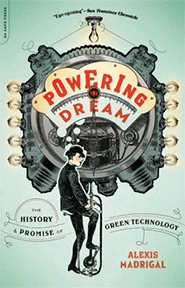By Germaine Cornelissen-Guillaume
Cheap energy shaped American life, shielding homes from cold or warm external temperatures and making possible the luxury of cars for anyone to travel almost anywhere any time. While concerns are now being raised about the consequences of the energy sources we use, impacting personal health, ecology, our environment, and the climate, Alexis Madrigal reminds us that choices between alternative green energy versus oil and gas are by far not new ideas. They have been tried in the past. His book presents the history, not often told, of the failures as well as some successes of past ventures into solar and wind energy, the choices made or missed, in an attempt to better understand how and why we arrived at our current infrastructure and technical reality.
A flourishing solar industry in California before World War II, electric cars of the early 1900s, a megawatt wind turbine in 1941, these are some of the stories covered in this amazing book, which includes a selection of old photographs as testimony to a different future that could have been but did not materialize. Through the author’s analysis, one is confronted with the fallacy of viewing existing technology as the best there is, any alternative necessarily inferior to the chosen path. Among competing new energy technologies, Madrigal argues that many of them succeeded in creating real alternatives, failing only because of lack of funding or scale and not because of lack of technical sophistication.
The problem with renewable energy is not the lack of technological know-how but rather the simple reality that to succeed it needs to be cheaper than coal. Collecting energy, whether it is from steam power, sun, wind, water, compressed air and electricity, or biomass, is only one side of the equation. Also needed are ways to store energy and to transport it safely across long distances. To be successful, size is important to cut costs. Madrigal walks the reader through the policies of several administrations that provided incentives for green energy to become viable, only to be discontinued after the election of a new president, sometimes when a breakthrough was imminent but ultimately failed because of lack of funding.
With renewed interest in electric cars, few may realize that at the turn of the 20th century, the competition between electric, gasoline, and steam-powered horseless carriages was real, each alternative having about one third of the market, not to mention proponents of horses. At the time, a gasoline-powered vehicle was described as “loud as a motorcycle at Sturgis, [it] vibrated like a jackhammer, threw off enough heat to burn its passengers, and belched smoke.” Curiously, one factor that tipped the scale from electric to gasoline power stemmed from cycling. The popularity of the bicycle laid the cultural, infrastructural, and legal groundwork for the privately owned, gasoline-powered vehicle’s dominance.
An award-winning technology writer, Alexis Madrigal opens a window into the past that will be equally appealing to historians and to all those concerned with technology and how it affects our environment. It is hoped that lessons learned from his scholarly research will help us make the right choices for a brighter future.




